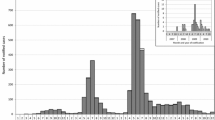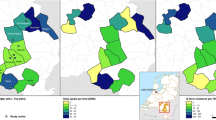Abstract
Objectives: A study was conducted to evaluate the extent of a Q-fever epidemic through active case finding in the area of Vicenza (northeastern Italy), and to identify risk factors for Q-fever in this outbreak.
Methods: 1) Descriptive epidemiology; 2) Seroepidemiological survey; 3) Case-control study. 1) Epidemic curve and maps with the location of cases. Identification of the road followed by the flocks of sheep. 2) Cross-sectional study on humans and flocks of sheep tested for anti-Coxiella burnetii antibodies. 3) Cases were defined by the presence of fever > 38 °C plus serological confirmation. Controls were 94 apparently healthy individuals attending outpatient facilities for control visits or certification, group-matched by geographical area, age and gender. A standardized questionnaire was administered by trained interviewers. Odds ratio and 95% confidence intervals (CI) were used to evaluate risk factors for Q-fever.
Results: A total of 58 cases were identified in a 5-month period. Male to female ratio was 2.8:1; mean age was 42 years (range: 20–65 years). Twenty-eight patients (48%) were hospitalized. Fever was accompanied by asthenia (81%), headache (76%), chills (72%), and myalgia and arthralgia (53%); cough was present in 47% of patients. Rx abnormalities were found in 81 % of the patients undergoing chest X-ray. Among 111 apparently healthy family members who underwent serological testing, four (3.6%) had antibodies to Coxiella burnetii. Three flocks which passed through the outbreak area between late May and early June were shown to be infected, with prevalence of antibodies ranging between 45 and 53%. The case-control study showed a significant association with exposure to flocks of sheep (Odds ratio = 6.1; 95% CI 2.5, 16.3). Other potential risk factors were not more commonly reported by cases with respect to controls.
Conclusions: Indirect exposure to flocks of sheep was a determinant of this outbreak of Q-fever. This finding suggests that transmission occurred through inhalation of contaminated airborne particles. The importance of control measures should be stressed in areas traversed by flocks of sheep.
Similar content being viewed by others
References
Sawyer LA, Fishbein D, McDade JE. Q fever: current concepts. Rev Infect Dis 1987; 9: 935–946.
Baca OG, Paretsky D. Q fever and Coxiella burnetii: a model for host-parasite interactions. Microbiol Rev 1983;47:127–149.
Langley JM, Marrie TJ, Covert A, Waag DM, Williams JC. Poker players' pneumonia. An urban outbreak of Q Fever following eposure to a parturient cat. Lancet 1988; ii: 354–356.
Babudieri B. Q fever. a zoonosis. Adv Vet Sci 1959: 5: 81–182.
Orsmbee RA. Q fever rickettsia. In Horsfall FL Jr, Tamm I, eds. Viral and rickettsial infections of man. 4th ed. Philadelphia: J B Lippincott, 1965: 1140–1160.
DeLay PD, Lennette EH, DeOme KB. Q fever in California. II, Recovery of Coxiella burnetii from naturally-infected air-borne dust. J Immunol 1950; 65: 211–220.
Lennette EH, Welsk HH. Q fever in California. X, Recovery of Coxiella burnetii from the air of premises harboring infected goats. American Journal of Hygiene 1951; 54: 44–49.
British thoracic Society Research Committee. Community-acquired pneumonia in adults in British hospitals in 1982–83: a BTS/PHLS survey of aetiology, mortality, prognostic features and outcome. Q J Med 1987; 239: 195–200.
Bernstsson E, Blomberg J, Lagergard T, Trollfors B. Etiology of community-acquired pneumonia in patients requiring hospitalization. Eur J Clin Microbiol 1985; 76: 233–272.
An epidemic of unusual pneumonia among troops returning from Southern Italy, June, 1945. A series of papers on Q fever. American Journal of Hygiene 1945; 44: 1–182.
Salmon MM, Howells B, Glencross EJH, Evans AD, Palmer SR. Q fever in an urban area. Lancet 1982; 1: 1002–1004.
Dupuis G, Petite J, Peter O, Vouilloz M. An important outbreak of human Q fever in a Swiss alpine valley. International Journal of Epidemiology 1987; 16: 282–287.
Sanzo JM, Garcia-Calabuig MA, Audicana A, Dehesa V. Q fever: Prevalence of antibodies to Coxiella burnetii in the Basque country. International Journal of Epidemiology 1993; 22: 1183–1188.
Tissot-Dupont H, Raoult D, Brouqui P, Janbon FPeyramond D, Weiller PJ, et al. Epidemiologic features and clinical presentation of acute Q fever in hospitalized patients: 323 French cases. Am J Med 1992; 93: 427–434.
Salmon MM, Howells B, Glencross EJG, Evans AD, Palmer SR. Q Fever in an urban area. Lancet 1982; i: 1002–1004.
Fishbein DB, Raoult D. A cluster of Coxiella Burnetii infections associated with exposure to vaccinated goats and their unpasteurized dairy products. Am J Trop Med Hyg 1992; 47: 35–40.
Millar JK. The chest film findings in ‘Q’ fever-a series of 35 cases. Clin Radiol 1978; 29: 371–375.
Dupuis G, Peter O, Pedroni D, Petite J. Aspects cliniques observes lors d'une epidemie de 415 cas de fievre Q. Schweiz med Wschr 1985; 115: 814–818.
Sobradillo V, Ansola P, Baranda F, Corral C. Q fever pneumonia: a review of 164 community-acquired cases in the Basque country. Eur Respir J 1989; 2: 263–266.
Peter O, Dupuis G, Peacock MG, Burgdorfer W. Comparison of enzyme-linked immunosorbent assay and complement fixation and indirect fluorescent-antibody tests for detection of Coxielle burnetii antibody. Journal of Clinical Microbiology 1987; 25: 1063–1067.
Welsh HH, Lennette EH, Abinanti FR, Winn JF. Airborn transmissio of Q fever: the role of parturification in the generation of infective aerosols. Ann NY Acad Sci 1958; 70: 528–540.
Author information
Authors and Affiliations
Rights and permissions
About this article
Cite this article
Manfredi Selvaggi, T., Rezza, G., Scagnelli, M. et al. Investigation of a Q-fever outbreak in Northern Italy. Eur J Epidemiol 12, 403–408 (1996). https://doi.org/10.1007/BF00145305
Accepted:
Issue Date:
DOI: https://doi.org/10.1007/BF00145305




